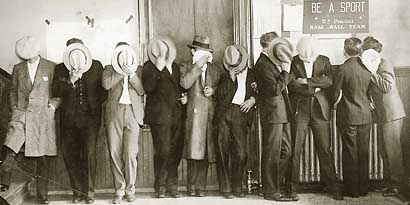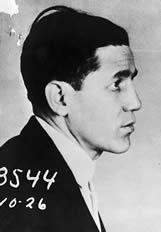- Home |
- About |
- Contact Us |
- RSS
The Purple Gang - Jewish Organized Crime
Detroit bootlegging gang whose existence was brief and extraordinarily violent

One characteristic of this group that made it quite unique was that it was the only Jewish crime organization to completely control the criminal underworld of a major American city. While other American Jewish gangsters worked within cross-ethnic alliances, the Purple Gang dominated Detroit entirely on its own. Like its criminally minded contemporaries, the Purple Gang was engaged in various criminal enterprises including bootlegging, hijackings, gambling operations, narcotics and kidnappings. And plenty of homicides were committed along the way.
Spawned from the Hasting Street neighborhood known as Paradise Valley in Detroit's Lower East Side, most of its core members went to Bishop School where each were placed in the division for problem children.
The children, who went on to become the Purple Gang, plied their trade as petty thieves and pickpockets in a large outdoor trading area called Eastern Market, adjacent to the Bishop School. The young men soon graduated to more lucrative ventures like loan sharking, extortion and hijacking under the tutelage of older neighborhood gangsters.
With the advent of Prohibition the Purple Gang was able to rise to the top of the Detroit underworld. As they gradually became over-extended they began to import hoodlums from other American cities to work as "muscle" for the gang, eventually leading to two of its most publicized homicides--the Miraflores and Collingwood Massacres.
There are numerous theories as to the origin of the name Purple Gang. One explanation is that a member of the gang was a boxer who wore purple shorts during his bouts. Others believe that the name came from a Hastings Street merchant who complained that these neighborhood kids were "tainted, off-color," like bad meat, "they're purple." Many dismiss these explanations and think it was merely a journalistic invention that stuck.

So feared were they during their "vivid reign of terror" that Al Capone decided against expanding his rackets into Detroit in favor of a business accommodation with the Purples. This allowed him to import liquor from Canada via the gang and to avoid a bloody war.
The Purples were involved in various criminal enterprises. They hijacked liquor from those who brought it across the border from Canada and were involved in the distillation of alcohol. They ran Blind Pigs (illegal bars also known as Speakeasies) and gambling operations. They were also involved in kidnapping other gangsters for ransom, which had become very popular during this era. In fact, because of their notoriety in kidnappings, the FBI considered them to be major suspects in the abduction of Charles Lindbergh's baby.
The following is a brief synopsis of the most sensational events that occurred during the reign of the Purple Gang:
1927 - Cleaners and Dyers War
This was a scheme in which the Purple Gang profited from the organization of Detroit laundry industry into unions and associations, who would then pay off the gangsters for "protection." Stench bombs, arson, beatings and homicides were all employed as organizing tactics. During this period, Abe Axler and Eddie Fletcher were imported in from New York as "muscle." In 1927, the core of the gang, including the Bernstein Brothers, Harry Keywell, Irving Milberg, Axler, and Fletcher were charged with conspiring to extort money from the organizations but acquitted of all charges.
March 1927 - Miraflores Massacre
This was the first use of machine gun in a homicide in Detroit. The three men who were killed had earlier been brought into Detroit as hired assassins for the Purple Gang and the motive for the murder was believed to be retaliation for a "double cross." The homicides took place in an apartment leased by Purple Gang members Eddie Fletcher and Abe Axler, which made them prime suspects in the slaying. However, no one was ever convicted of the murder.
January 1928 - Murder of Police Officer Vivian Welch
Detroit Police Officer Vivian Welch had been suspected of shaking down blind pigs and bootleggers throughout Detroit. He was killed after attempting to extort money from a Purple Gang operation. Eyewitnesses related that after Welch had been shot and down on the ground, a gunman stood over him and shot multiple rounds into his body. The killers then ran over his body with a car. No one was ever convicted of the murder.
July 1930 - Arthur Mixon Homicide
Philip Keywell and Joe Miller murdered 15-year-old, Arthur Mixon, after the boy unknowingly peaked inside a Purple Gang liquor "cutting plant" (a place where the alcohol is watered down in order to produce larger quantities). They were the first Purple Gang members to be convicted of murder.
September 1931 - Collingwood Massacre
This was a triple homicide involving Chicago gangsters who had been imported into Detroit to help out the Purple Gang and had been encroaching on Purple Gang rackets. The men, Hymie Paul, Isadore Sutker a.k.a. Joe Sutker, and Joe Lebowitz were lured into an apartment in order to work out a truce. All three were gunned down. Ray Bernstein, Harry Keywell and Irving Milberg were convicted of the murders and sentenced to life in prison.
November 1933 - Abe Axler and Eddie Fletcher Taken for Ride
Soon after being declared Detroit law enforcement's joint Public Enemies Number One, Axler and Fletcher were found dead in the back seat of a car, on a desolate road just outside Detroit. The men were both shot point blank in the face and found with their hands intertwined. The hands were placed together post-mortem as a final act of disrespect. No one was ever convicted of the murders.
1937 - Harry Millman Assassinated
After several failed assassination attempts--these included a car bombing in which an innocent valet who was retrieving Millman's car was killed--Millman is assassinated, in a downtown restaurant/bar, purportedly by members of Murder, Inc..
The Purple Gang's first major attention came in 1927 when most of its core was charged with extorting money from labor unions and trade associations related to Detroit's laundry industry. In fact, these organizations had been established by members of the Purple Gang in a scheme to maximize profits from the workers and small business owners. The events were known as the Cleaners and Dyers War: Beatings, arsons, factory explosions, and homicides all took place in an effort to keep the scheme running.
There are many amusing accounts from witnesses at the 1927 trial of union meetings where some gangster or another would show up to give a speech with such inspirational messages as: "Pay up or else."
In certain respects, the Purple Gang was like any other criminal group during Prohibition or any era. Motivated by the prospect of money and power and coming from humble origins, they took to a life of crime. What made them unique was that unlike their Jewish counterparts engaged in crime in various American cities, the Purples not only controlled crime in their city, but their ranks were almost exclusively composed of Jews. In cities like New York and Chicago, alliances had formed between Italians, Jews and the Irish. These groups understood the power of cross-ethnic mergers and were willing to put aside ethnic differences in pursuit of more lucrative business practices.

The gang's downfall came as a result of myriad factors.
There was infighting among various factions of the gang as well as outside gangsters, who were forever attempting to cheat each other out of territory and profits; robbing each other's gambling dens and blind pigs; and hijacking liquor shipments. There were brutal reprisals, as evidenced in the Miraflores and Collingwood Massacre, in which rival gangsters were murdered as examples to potential rivals. All of this bloodshed led to unwanted attention by the police, the District Attorney, the press, and the public, who sought to put the Purple Gang out of commission.
The result was prosecutions and convictions--small and large.
The death knell was dealt by the local Sicilian mob headed by Joseph Zerilli, who sensed that the gang was hobbled and moved in. The Sicilians formed partnerships with whomever they deemed necessary and eliminated everyone else. It is believed that Harry Millman, Abe Axler, Louis Fletcher and Irving Shapiro were all murdered as result of the warring with the Sicilians. By 1931, the gang was only a shadow of its former power.
Epilogue:From the sheer criminality they exhibited it would seem that this was an organization whose days were numbered from the time the first body hit the ground. Most of the gang were either gunned down on the streets or died in prison (or soon after release) of various ailments. Some continued on with their criminal exploits but mostly in a diminished capacity. It was alleged that Abe Bernstein continued to run his bookmaking services from his suite at the Book-Cadillac Hotel in Detroit until he died of a stroke in 1968.
What follows are the conclusions to the lives of the core members of the Purple Gang:
Philip Keywell
Sentenced to life in prison in 1930 for murder.
Morris Raider
Sentenced to 12-15 years in prison in 1930 for murder.
Harry Millman
Assassinated in November 1937.
Raymond Bernstein
Sentenced to life in prison in 1931 for murder.
Irving Milberg
Sentenced to life in prison in 1931 for murder.
Harry Keywell
Sentenced to life in prison in 1931 for murder.
Abe Axler
Assassinated in November 1933.
Eddie Fletcher
Assassinated in November 1933.
Ziggy Selbin
Assassinated in October 1929.
Irving Shapiro
Assassinated in July 1929.
Harry Fleisher
Alcatraz Inmate #320.
Sam Fleisher
Alcatraz Inmate #327.
It would seem crime doesn't pay.
- The Purple Gang were estimated to have been responsible for 500 unsolved murders in the span of just five incredibly violent years, topping even Al Capone's body count.
Some of these sites were used as source material for this entry and may be of interest to those looking to learn more about this person/topic.
- The Purple Gang by Paul Kavieff
- The Detroit News - Detroit's Infamous Purple Gang
- Federal Bureau of Investigation - The Purple Gang
- Court TV Crime Library - The Purple Gang: Bootlegger's Paradise
- My Jewish Learning - Detroit's Purple Gang
- Google Books - Mobsters, Mayhem & Murder
- Rearview Mirror The Detroit News - The Purple Gang's bloody legacy
SEE ALSO
 Copy the text below to cite your paper or article:
Copy the text below to cite your paper or article: 
